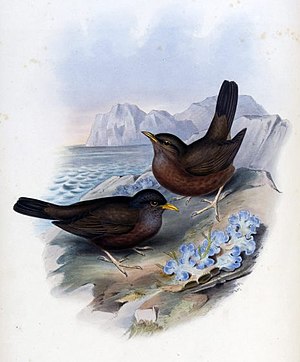Lord Howe Island Thrush
| Lord Howe Island Thrush | ||||||||||||
|---|---|---|---|---|---|---|---|---|---|---|---|---|

Lord Howe Island Thrush ( Turdus poliocephalus vinitinctus ) |
||||||||||||
| Systematics | ||||||||||||
|
||||||||||||
| Scientific name | ||||||||||||
| Turdus poliocephalus vinitinctus | ||||||||||||
| ( Gould , 1855) |
The Lord Howe Island Thrush ( Turdus poliocephalus vinitinctus ), known by the islanders as the Ouzel or Doctor Bird , is an extinct subspecies of the South Sea Thrush ( Turdus poliocephalus ) that was endemic to Lord Howe Island .
It reached a length of 22.9 centimeters. The head was olive brown, the top was maroon, wings and tail were dark brown, throat and chin were pale brown with an olive tinge. The underside was maroon with a lavender tint.
In 1906 it was still relatively common, but its population began to decline from 1913. Introduced goats destroyed their habitat and dogs , cats and feral pigs stalked them. The main reason for their extinction was most likely the shipwreck of the SS Makambo in June 1918. After the SS Makambo ran aground , rats came to Lord Howe Island and within six years the rats reproduced so strongly that several land bird species, including the Lord- Howe Island Thrush, were exterminated.
Museum specimens are available in Leiden ( Netherlands ), Tring ( United Kingdom ), Berlin , New York , Washington and Sydney .
literature
- JC Greenway: Extinct and Vanishing Birds of the World. Dover Publications, New York 1967, ISBN 0-486-21869-4 .
- D. Day: The Doomsday Book of Animals. London 1981, ISBN 0-85223-183-0 .
Web links
- Lord Howe Island Thrush in the Naturalis Museum, Leiden ( Memento from July 17, 2011 in the Internet Archive )